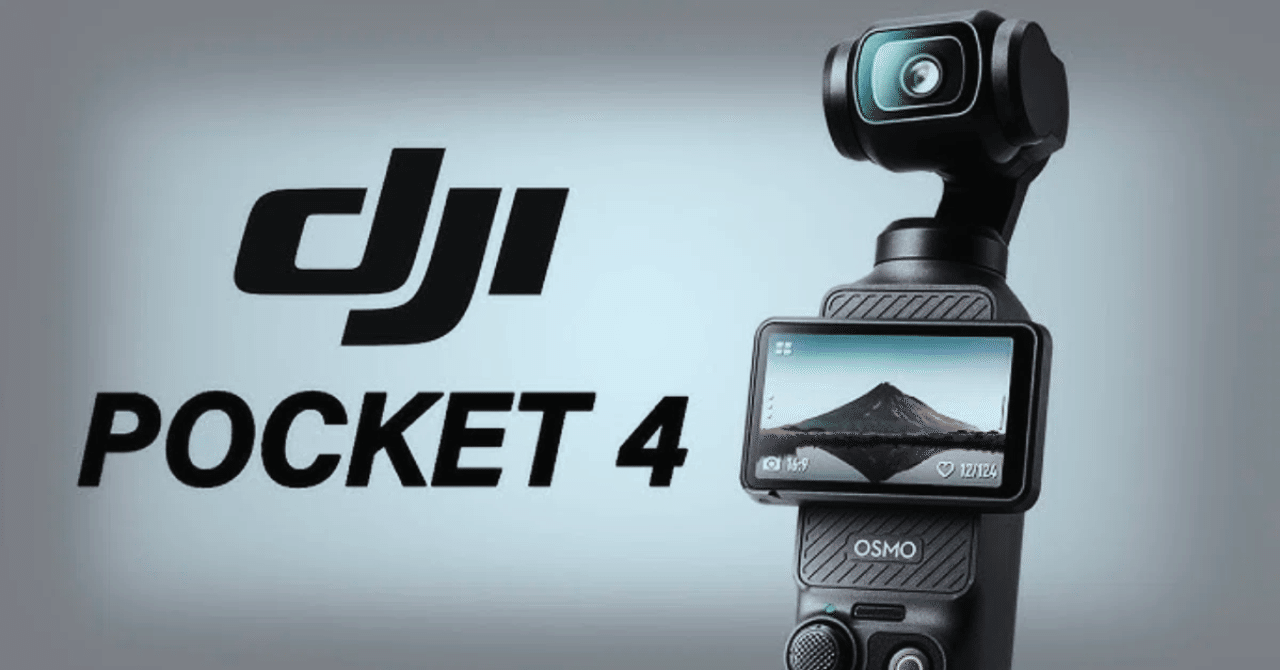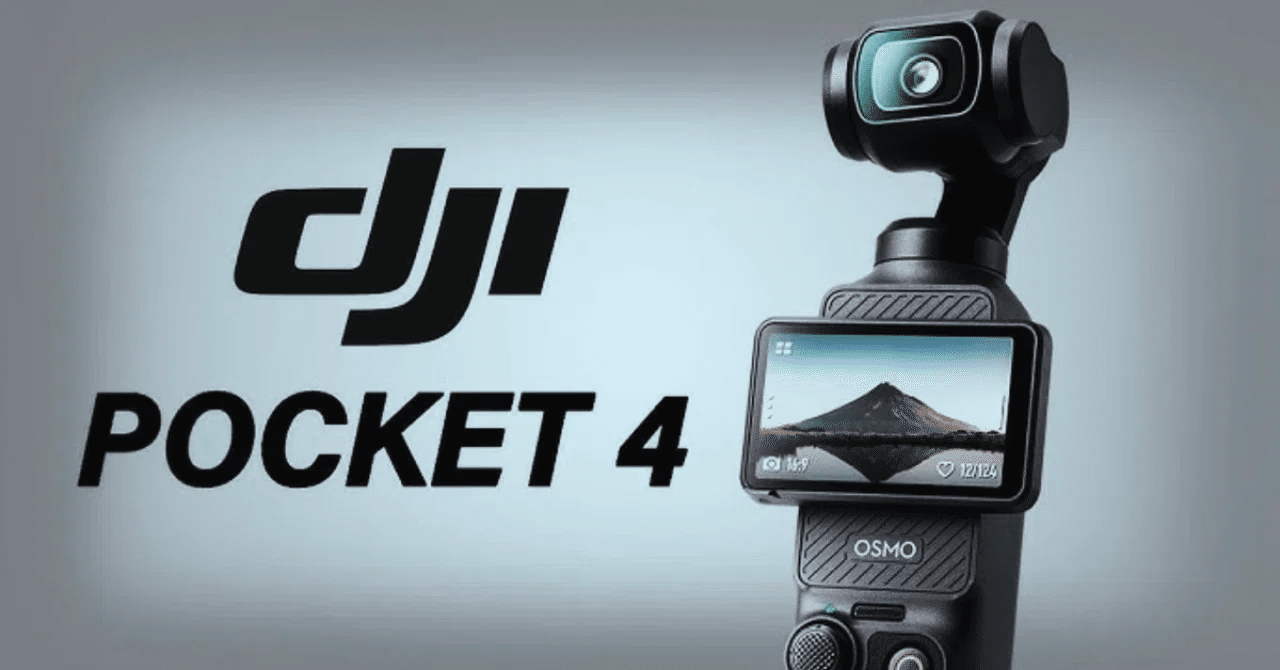
DJI Osmo Pocket 4: The Innovation of the Next-Generation Handheld Camera

Introduction
The DJI Osmo Pocket 4 is capturing the attention of video creators with its blend of compact design and professional performance. Building on the success of the Osmo Pocket 3, which was popular among vloggers, YouTubers, and travel creators for its 4K capabilities in a small form factor, the Osmo Pocket 4 is expected to take things to the next level. With advanced camera technology from its collaboration with Hasselblad, a larger sensor, a new processor, and improved software features, this article will explore the rumored specifications and features of the Osmo Pocket 4 and what they mean for creators.
Hasselblad Collaboration: A Leap in Image Quality
A key highlight of the Osmo Pocket 4 is the integration of Hasselblad’s renowned camera technology. Hasselblad is celebrated for its exceptional color science, detailed imagery, and advanced optics, and has previously collaborated with DJI on premium drones like the Mavic 4 Pro. Bringing this technology to a handheld camera marks a significant milestone for the Osmo Pocket series, potentially enabling image quality that surpasses both previous models and competitors.
Furthermore, reports suggest that DJI plans to acquire up to 75% of Hasselblad’s shares, further strengthening their partnership. This could lead to Hasselblad’s technology being widely integrated across DJI’s product lineup, making devices like the Osmo Pocket 4 standard with professional-grade camera systems. For creators, this means the ability to capture high-quality footage with a compact device, reducing the need for extensive editing and post-processing.
1-Inch CMOS Sensor: Superior Performance in Low Light
The Osmo Pocket 4 is rumored to feature a 1-inch CMOS sensor. While this is the same size as the sensor in the Osmo Pocket 3, the new model is expected to offer improved performance in low-light conditions and better dynamic range thanks to a new design and enhancements. A 1-inch sensor can capture more light and reproduce fine details more clearly, which is particularly beneficial for shooting in low-light environments or indoors, where it can produce clear images and videos with less noise.
This sensor is paired with a 20mm F2.0 wide-angle lens, providing a broad field of view ideal for vlogging, landscape photography, and group selfies. The 20mm focal length allows creators to include more of the background in their shots, adding depth and context to their videos, which is especially useful for travel vloggers and those who want to emphasize their surroundings. Additionally, the large sensor offers superior dynamic range, enabling balanced footage even in high-contrast scenes with both bright and dark areas.
New Processor: Real-Time HDR and Fast Processing
The Osmo Pocket 4 is expected to come with a new processor that offers significantly improved performance over the previous model. This processor will enable faster data processing, more efficient video compression, and support for new features such as real-time HDR preview. The real-time HDR feature allows users to accurately check the brightness, contrast, and color balance of their footage before recording, making it easier to capture perfect shots in challenging lighting conditions like sunrises, sunsets, or scenes with both shadows and highlights.
Moreover, the new processor is expected to power advanced computational photography tools, including smarter auto settings and more realistic color rendering, especially when combined with Hasselblad’s color science. This means creators can spend less time on post-production and more on storytelling and content creation.
Enhanced Autofocus: Phase Detection and Eye Tracking
The autofocus performance of the Osmo Pocket 4 is also expected to see significant improvements. Rumors suggest the inclusion of phase detection autofocus (PDAF) and eye tracking. PDAF allows the camera to quickly and accurately focus on moving subjects, while eye tracking can automatically detect and maintain focus on a person’s face or eyes, even in dynamic scenes. These features are particularly useful for vlogging and action shots, where maintaining focus can be challenging.
By reducing focus hunting—where the camera repeatedly adjusts focus without settling—the Osmo Pocket 4 will provide a more reliable and smoother shooting experience, ensuring that footage remains sharp and professional-looking.
ActiveTrack 7.0: Next-Level Subject Tracking
DJI’s ActiveTrack technology, which allows the camera to automatically follow and frame subjects, is a standout feature in both drones and handheld cameras. The Osmo Pocket 4 is expected to include ActiveTrack 7.0, which promises enhanced stability, accuracy, and subject recognition. This means creators can move freely—walking, running, or even biking—while the camera keeps them perfectly framed without the need for manual adjustments or an additional camera operator.
For solo creators, this feature is invaluable, as it simplifies the process of capturing dynamic shots without needing extra help, allowing for more creative freedom and professional results.
Design and Portability: Compactness Maintained
In terms of design, the Osmo Pocket 4 is expected to retain the series’ signature slim, vertical form factor, which makes it easy to hold with one hand and incredibly portable. Its pocket-sized body allows creators to film on the go without being weighed down by bulky equipment.
The camera will also feature the series’ hallmark 3-axis mechanical gimbal, essential for capturing smooth, shake-free footage. Unlike digital stabilization found in smartphones or action cameras, which can crop the frame or reduce image quality, the mechanical gimbal ensures high-quality, stable video even during movement.
Software Evolution: Efficient Content Creation
On the software side, DJI is expected to introduce an updated user interface and enhanced editing and sharing capabilities through its companion app. With a more powerful processor and AI capabilities, the Osmo Pocket 4 could offer on-device video effects, smart editing suggestions, and faster file transfers, streamlining the entire content creation process from recording to uploading.
This is particularly beneficial for creators who need to shoot and share content in real-time, such as for social media or live events, making the workflow quicker and more efficient.
Price and Competitive Comparison
While the price of the Osmo Pocket 4 has not been officially announced, it is likely to be slightly higher than the Osmo Pocket 3, which currently retails for around $799.99 on Amazon, due to the inclusion of a new sensor, Hasselblad technology, and improved internals. However, compared to competitors like the Insta360 A2 Pro, which features Leica branding, the Osmo Pocket 4 could offer a compelling combination of compactness and professional performance.
For creators who prioritize portability without sacrificing quality, the Osmo Pocket 4 could be the perfect tool, especially for vlogging and travel videography, where space and weight are at a premium.
Conclusion
In conclusion, the DJI Osmo Pocket 4 is shaping up to be a highly anticipated next-generation handheld camera, with features like Hasselblad camera technology, a 1-inch CMOS sensor, a new processor, ActiveTrack 7.0, improved autofocus, and real-time HDR. Its compact design and professional capabilities make it an ideal device for vloggers, YouTubers, and travel creators. As DJI and Hasselblad continue to collaborate, we can expect even more innovative imaging devices in the future. The Osmo Pocket 4 has the potential to be the all-in-one solution that creators have been waiting for.
Link
You can also check the latest information on the DJI Osmo Pocket 4 on X (formerly Twitter) at @getgadgetgot. Follow to make sure you don’t miss the latest updates!
DJI Osmo Pocket 4: Latest Information and Expected Features
The latest information about the DJI Osmo Pocket 4 is creating a significant buzz among video creators and gadget enthusiasts. Below is a summary of the latest rumors and expected features as of June 2025. Please note that these details are based on pre-official-announcement speculation and the actual product specifications may differ.
Camera and Image Quality Evolution
Through a collaboration with Hasselblad, the Osmo Pocket 4 is expected to be the first handheld camera to feature Hasselblad camera technology. This marks a groundbreaking step, bringing the advanced technology used in DJI’s premium drones (e.g., Mavic 4 Pro) to a ground-based device.
The 1-inch CMOS sensor will retain the same size as the Osmo Pocket 3 but features a new design that improves noise reduction in low-light conditions and enhances dynamic range. A resolution of 12MP is possible (up from the Osmo Pocket 3’s 9.4MP), though rumors of a 100MP sensor are considered unlikely to materialize.
Video performance is expected to reach 4K/240fps (an upgrade from the Osmo Pocket 3’s 120fps), with support for 3K/120fps for vertical videos. It will also support 10-bit color, D-Log M, and HDR recording, making color correction easier for professional use.
Screen and Usability
A 2.5-inch large touch screen (up from the Osmo Pocket 3’s 2-inch display) is anticipated, offering a brighter, crisper, and more responsive display.
Button placement has been improved for better ergonomics, and the addition of joystick-style controls is also a possibility.
Design and Durability
The weight is approximately 190g, slightly heavier than the Osmo Pocket 3 but still maintaining its pocket-sized form. Heat management has been enhanced, ensuring comfortable use during extended shooting sessions.
In response to user demands, the device may feature added weather resistance against light rain and dust. While not fully waterproof, an IP54-equivalent protection level is expected.
Gimbal and Stabilization
An upgraded 3-axis gimbal combined with Electronic Image Stabilization (EIS) will enable stable video recording even during intense activities like biking or hiking.
The introduction of a slip ring could allow for 360-degree infinite panning.
AI Tracking and Autofocus
ActiveTrack 7.0 is expected to offer improved face and eye tracking accuracy, with smoother subject switching. It will also handle fast-moving subjects, such as pets or children.
Phase Detection Autofocus (PDAF) and eye-tracking technology will enhance focus precision for vlogs and dynamic scenes.
Battery and Charging
A battery life exceeding the Osmo Pocket 3’s 90 minutes is anticipated, with fast charging capable of a full charge in 25 minutes. Improved heat management will ensure stability during long recordings.
Support for swappable batteries or external battery packs is also hoped for.
Accessories
The Creator Combo is expected to include a wireless microphone, mini control stick, tripod mount, wide-angle lens, waterproof case, telephoto lens, ND filter set, external battery pack, and Bluetooth live streaming module.
Rumors
-
Release Date: The community anticipates a launch around November 2025, though predictions also range from late 2026 to early 2027. The decreasing stock of the Osmo Pocket 3 is seen as a potential sign of a new model announcement.
-
Price: The standard model is estimated at approximately $699 (about 105,000 yen, based on 1 USD = 150 JPY), with the Creator Combo priced at around $799 (about 120,000 yen).
-
Zoom Lens Possibility: Some users hope for a triple-lens setup (wide-angle, telephoto, ultra-wide-angle) with added zoom functionality.
-
100MP Sensor Rumor: While a 100MP sensor has been discussed, it is considered unlikely to be realized.
-
Weather Resistance: There is strong demand for weather resistance against light rain and dust, with an IP54-equivalent protection level being expected.
-
Osmo Pocket 3 Update Impact: The major update to the Osmo Pocket 3 in February 2025, which added new features, may potentially delay the release of the Osmo Pocket 4.
You can also check the latest information on the DJI Osmo Pocket 4 on X (formerly Twitter) at @getgadgetgot. Follow to make sure you don’t miss the latest updates!


